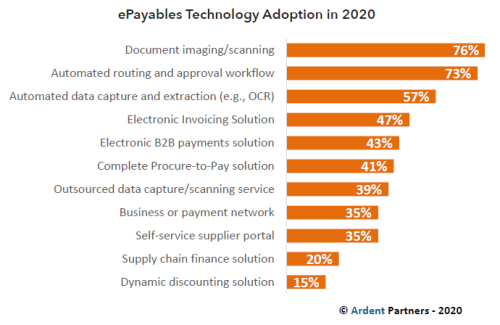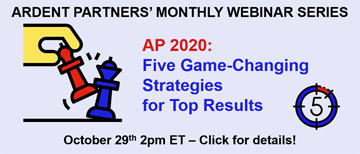According to Ardent’s 2020 State of ePayables market research report, 62% of AP leaders stated that the pandemic did not create a need to invest in automation, as accounts payable processes were “already automated.” The reality, however, is that many AP teams have not fully-adopted and/or optimized their technology. This becomes clear when a deeper analysis of the current AP technology landscape is performed (see figure below). For example, while it is true that a majority of AP organizations have some level of ePayables automation in place, typically at the front-end of the process (i.e., document imaging/scanning (76%) and automated data capture and extraction (57%)), far fewer organizations have broad automation coverage across their full scope of operations.

Unpacking the technology adoption stats in the figure above reveals that a majority of today’s AP teams are not fully-automated, but instead have taken more of a piecemeal approach. For example:
- Only 41% of businesses today have complete procure- to-pay automation in place, which shows that gaps between AP and procurement still exist. In tough times, businesses should require all teams to be unified and focused on the most important things. The post-pandemic world will increase the general focus on managing supplier costs and payments. Wide technology and/or process gaps between the two groups makes it more difficult to fully capture savings and ensure contract compliance. Whether via integrated or closed-loop solutions, full automation across the requisitioning/purchasing, invoice, and payment processes can reduce operational costs and help enterprises optimize their supply chains.
- Less than half (47%) of all AP teams use eInvoicing, which is a missed opportunity for many to drive next-level efficiency. Accounts payable departments tend to focus on the “Process” phase of Ardent’s ePayables Framework (Receive, Process, Pay) and less so on the other two. Electronic invoicing enables automated transmission of invoices between suppliers and buyers, which in and of itself is a boon (through the elimination of paper invoices). But eInvoicing also enables the electronic transmission of more accurate data, creating the opportunity for more “touchless” processing and helps to mitigate many of the invoice exception woes that currently plague AP groups.
- The adoption of electronic B2B payments (43%) continues to rise. This is promising and an area that hits at the core of AP’s most strategic opportunity in the near- term. It is an area that deserves much more focus because enterprise inertia, driven by a resistance to change, is typically one of the biggest obstacles that enterprise functions must overcome on the pathway to organizational transformation. (For more information on electronic payments and leaders in this space including – Bottomline, MineralTree, Paymerang, AvidXchange, Tipalti, and Tradeshift, please refer to Ardent Partners’ recently released B2B Payments Technology Landscape Report).
The adoption of ePayables technology remains widely varied in the market today. Slowly but surely we are seeing more and more leading organizations understanding the value that AP automation brings on many different levels including maintaining business continuity, improving cash management, and supporting supply chain resiliency.
RELATED RESEARCH
Tagged in: AP Automation, Bob Cohen, eInvoicing, ePayables, ePayables 2020, Solution Providers, State of ePayables, Technology










